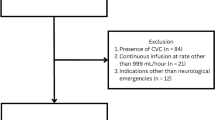Abstract
Spontaneous intracranial hypotension (SIH) is an uncommon condition caused by cerebrospinal fluid leakage. We report of a 29-year-old woman with typical symptoms in whom initial cranial MRI and CT were normal . A clinical diagnosis of SIH, but the symptoms did not resolve with conservative therapy or a lumbar epidural blood patch. Repeat MRI revealed (indirect) findings consistent with SIH but failed to directly demonstrate a cerebrospinal fluid fistula. Subsequent CT myelography revealed leakage of contrast medium into the epidural space bilaterally along the nerve roots at C3–7. Following the myelography the patient reported dramatic clinical improvement with complete resolution of symptoms. The adhesive quality of the myelographic contrast medium might have precipitated closure of the meningeal tears. Myelography may be not only of diagnostic value but also therapeutic in SIH.




Similar content being viewed by others
References
Rando TA, Fishman RA (1992) Spontaneous intracranial hypotension. Neurology 42: 481–487
Anon (1998) Massachusetts General Hospital. Case records of the weekly clinicopathological exercises N Engl J Med 338: 180–188
Gaukroger PB, Brownridge P (1987) Epidural blood patch in the treatment of spontaneous low CSF pressure headache. Pain 29: 119–122
Ly JN, Desilva SJ, Brazier D (1999) Spontaneous intracranial hypotension. Australas Radiol 43: 548–550
Huang C, Chuang Y, Lee C, et al (2000) Spontaneous spinal cerebrospinal fluid leak and intracranial hypotension. Clin Imaging 24: 270–272
Jeon TJ, Lee JD, Lee BI, et al (2001) Radionuclide cisternography in spontaneous intracranial hypotension with simultaneous leaks at the cervicothoracic and lumbar levels. Clin Nucl Med 26: 114–116
Walpole JB (1975) Blood patch for spinal headache. Anaesthesia 30: 783–785
DiGiovanni AJ, Galvert MW, Wahle WM (1972). Epidural injection of autologous blood for post lumbar puncture headache. Anesth Analg 51: 226–232
Duffy PJ, Crosby ET (1999) The epidural blood patch. Resolving the controversies. Can J Anaesth 46: 878–886
Cook MA, Watkins-Pitchford JM (1990). Epidural blood patch: a rapid coagulation response (letter). Anesth Analg 70: 567–568
Waguri N, Tomita M, Hayatsu K, et a. (2002) Epidural blood patch for treatment of spontaneous intracranial hypotension. Acta Anaesthiol Scand 46: 747–750
Author information
Authors and Affiliations
Corresponding author
Rights and permissions
About this article
Cite this article
Jeyrani, R., Paul, A., Doerfler, A. et al. Intracranial hypotension due to leakage of cerebrospinal fluid: could myelography be a therapeutic option?. Neuroradiology 47, 43–45 (2005). https://doi.org/10.1007/s00234-003-1089-7
Received:
Accepted:
Published:
Issue Date:
DOI: https://doi.org/10.1007/s00234-003-1089-7




